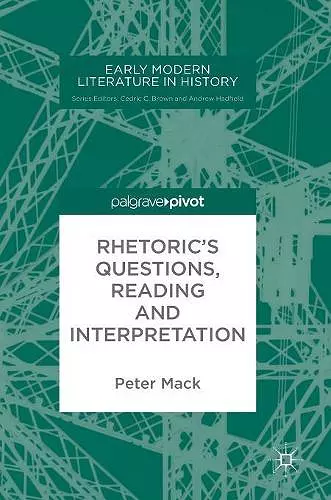Rhetoric's Questions, Reading and Interpretation
Format:Hardback
Publisher:Springer International Publishing AG
Published:1st Sep '17
Currently unavailable, and unfortunately no date known when it will be back

"For over a year I have been privileged to use in my classes the list of questions around which Peter Mack's new publication is constructed. They are the single best tool that I have found to help students determine ways not only to think about texts but more importantly to approach writing about them. Rhetoric's Questions models how to use these questions to analyze significant literary texts, both historical and contemporary, with sophistication and depth. It is an invaluable resource." (Marjorie Curry Woods, Jane and Roland Blumberg Centennial Professor of English, The University of Texas at Austin, USA) "We are familiar today with the ways that rhetoric can help in the teaching of writing and speaking, but less familiar with its role in teaching how to read and listen. But production and interpretation of discourse are reciprocal with one another, and Peter Mack's provocative book on Rhetoric's Questions restores rhetoric to its rightful place as a discipline that shows us how doing either activity teaches us to do the other. The history of rhetoric is a history of responses to a series of enduring and inescapable questions about human discourse, responses that range from reductive school books to philosophical treatises. Mack demonstrates that the now-familiar rhetorical answers to questions about how to produce discourse arise from answers to fundamental and ever-present questions about how to understand discourse. To teach the questions of rhetoric is simultaneously to teach how to read and write, to listen and speak, to understand and act." (Lawrence D. Green, Professor of English and Director of Undergraduate Studies at University of Southern California, USA) "Rhetoric's Questions is an immensely thoughtful and intelligent guide for readers which outlines the essentials of rhetorical theory and criticism and explains why a knowledge of rhetoric is so valuable for contemporary readers, whatever their particular interests. Peter Mack is a major scholar and critic of rhetoric whose work has explained and illuminated the ways in which the work of Greek and Latin writers was adopted and adapted by thinkers in the European Renaissance to establish how we write and read today. In this short, invaluable, and accessibly-written book, Professor Mack provides an overview of the major rhetorical writers; the strategies they adopted and recommended; and a wealth of examples from Chaucer to Salman Rushdie, to explain how rhetorical theory shapes the writing that we all read and so mediates how we access the world. It is hard to imagine any readers who will not learn a great deal from the author's insights." (Andrew Hadfield, Professor of English at University of Sussex, UK and Chair for Society for Renaissance Studies)
This book aims to help readers interpret, and reflect on, their reading more effectively. It presents doctrines of ancient and renaissance rhetoric (an education in how to write well) as questions or categories for interpreting one’s reading. The first chapter presents the questions. Later chapters use rhetorical theory to bring out the implications of, and suggest possible answers to, the questions: about occasion and audience (chapter 2), structure and disposition (3), narrative (4), argument (5), further elements of content, such as descriptions, comparisons, proverbs and moral axioms, dialogue, and examples (6), and style (7). Chapter eight describes ways of gathering material, formulating arguments and writing about the texts one reads. The conclusion considers the wider implications of taking a rhetorical approach to reading. The investigation of rhetoric’s questions is interspersed with analyses of texts by Chaucer, Sidney, Shakespeare, Fielding and Rushdie, using the questions. The text is intended for university students of literature, especially English literature, and rhetoric, and their teachers.
ISBN: 9783319601571
Dimensions: unknown
Weight: 2737g
112 pages
1st ed. 2017